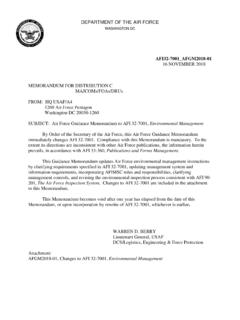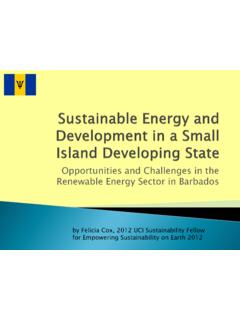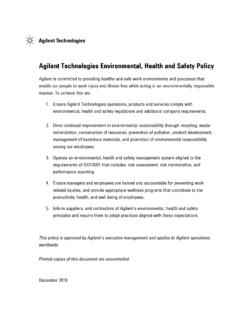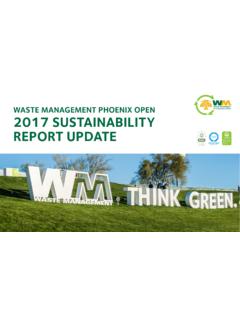Transcription of Sustainability - Ms.Williams' Science Site
1 Sustainability Learning Goals Evaluate human behaviors in terms of how likely they are to ensure the ability to live sustainably Evaluate the concept of reduce, reuse, recycle in terms of impact on natural resources. Judge potential impact of sustainable techniques on environmental quality (include magnitude, duration, frequency). Definition of Sustainability Methods that do not completely use up or destroy natural resources Living in a way that allows resources to last or continue for a long time Definition (continued .). Individual efforts made by YOU to ensure that the beauty and benefits of today's world . economically, environmentally and socially will be available for future generations to inherit. Reduce, Reuse, Recycle Three great ways YOU can eliminate waste and protect your environment!
2 Think in terms of how you can implement each practice in your daily life Human Survival Needs Human have survival needs . 1. Food 2. Water 3. Energy 4. Shelter 5. Homes, 6. Clothing (protection from the elements ). 7. Clean air POPULATION GROWTH. POPULATION GROWTH. Number of births Number of deaths Emigration (out) & Immigration (in). Population Density the number of individuals in an area Growth Rate Positive Growth rate = population increase Negative Growth rate = decrease GROWTH RATE. Human population is growing exponentially on our planet. World Population over 6 billion Exponential Growth . reproduce at a constant rate. Occurs under ideal conditions (no limits). J-shape curve HISTOGRAM A TYPE OF BAR GRAPH. Age Structure (aka Age-Sex) Histograms - Shows the number of people by gender and by age in a given population.
3 Example: Having a wide base and a thin top to the histogram shows that a lot of people are being born and few will be dying off (Mexico). If the chart is fairly consistent all the way up, there is very little change taking place (Sweden). CARRYING CAPACITY. Maximum population size an environment can sustain When a population out grows the carrying capacity then limiting factors may come into effect. EXPONENTIAL GROWTH VS. CARRYING CAPACITY. LIMITING FACTORS. Factors that cause population growth to decrease Can be biotic or abiotic Bioticsuch food source of plants or animals Abiotic such as light, temperature, soil, weather 2 KINDS OF LIMITING FACTORS. 1. Density-dependent depends on population size Examples disease, parasites, competition, predators, and food 1. Density- independent does not depend on population size can affect populations regardless of their density Usually abiotic factors such as weather, climate, natural disasters (floods, volcanic eruptions, etc).
4 Aquaculture Aquaculture is becoming an increasingly important source of fish and other food organisms. Aquaculture involves farming fish or other aquatic organisms under artificial and controlled conditions such as: Ponds, cages, lakes, or closed off sections of the sea. Aquaculture Facts About 120 million metric tons of fish are consumed per year. In some areas of the world, freshwater fishing is important for local economies and freshwater aquaculture is common. However on an international scale, most fishing takes place in the ocean. Aquaculture and Genetic Engineering Some of the aquatic organisms in aquaculture are genetically engineered. There are concerns that when genetically engineered fish escape into the environment, they will alter the genetic make-up of wild fish.
5 OVERFISHING. Modern large fishing vessels use fishing techniques that are rapidly lead to overfishing. HOW? If nets with a fine mesh are used, then young fish are caught which negatibely impacts the future breeding population. Year-round fishing may also lead to capturing fish during important spawning (reproduction)seasons. Future fish stocks are diminishing because of overfishing in breeding areas of water In the Atlantic, catches of cod, haddock, and red hake have all declined. Controlling Aquaculture All countries with a coastline have areas over which they control fishing. Most countries have regulations determining the methods of fishing allowed and the seasons in which it can be conducted. Some countries, such as Canada and the United States, carefully monitor fishing in their waters.
6 By regulating fishing zones, net mesh size, fishing season, and catch quotas governments have helped depleted fishing stocks recover. In international waters outside these limits, there are no such regulations. Sustainable Farming and Fishing It is impossible to prevent all the negative impacts of growing food. sustainable agriculture= reducing the impact of aquaculture and agriculture by using techniques based on our understanding of ecology. Sustainable agriculture uses plant and animal production techniques that are carefully tailored to fit the ecology of the local area. These techniques are designed not to deplete natural resources. This approach has many positive impacts Positive Impact of Sustainable Farming Reduces or eliminates fossil fuel inputs Reduces or eliminates the use of artificial fertilizers Removes pesticides from the environment Recycles plant and animal waste on the farm Grows crops adapted to local conditions Provides more humane conditions for livestock Produces food for sale in local markets, thereby reducing transport costs.
7 Challenges to Sustainable Agriculture Sustainable agriculture is often more labor intensive than its industrial counterpart. It is also possible that food produced by this approach will be more expensive. Why do we need sustainable seafood? 80 percent of the world's marine populations are fully fished, over-exploited, depleted, or recovering from depletion. If wild-caught seafood is going to be available in the future, it is critical that sustainable fishing practices are followed Example: Whole Foods Market is committed to working with organizations such as the Marine Stewardship Council, Blue Ocean Institute, and Monterey Bay Aquarium to advance the market for sustainable seafood.




